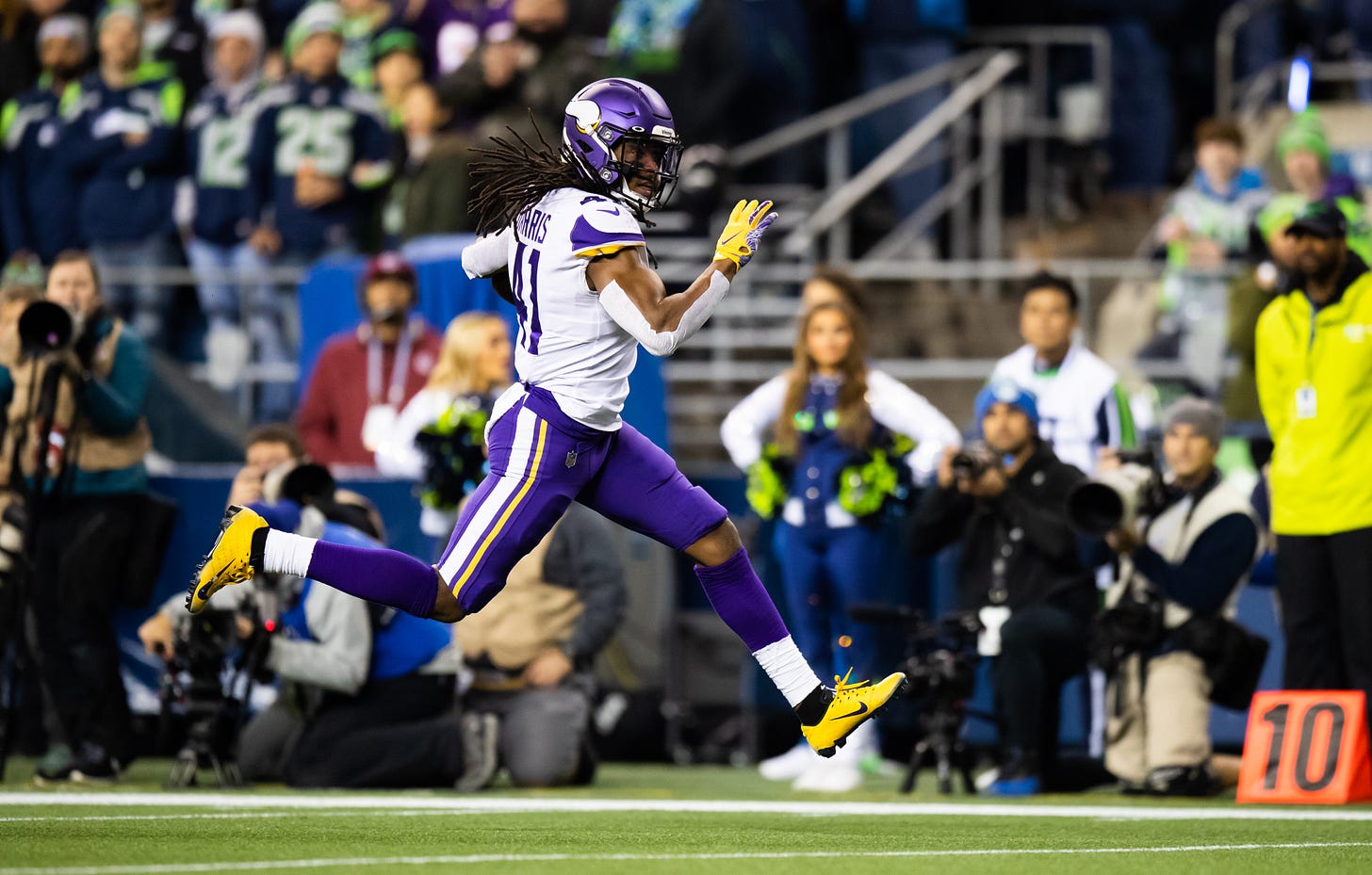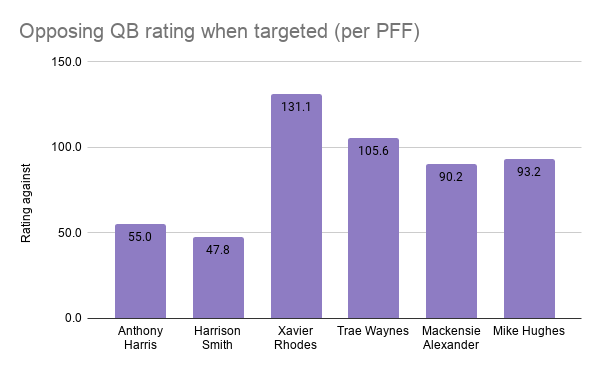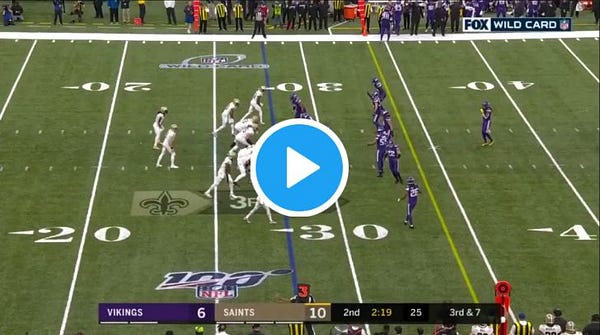Why Vikings' decision to franchise tag Anthony Harris will pay off
What was once a surprise move now appears to have been a smart play

*Photo courtesy of the Minnesota Vikings
Welcome to Purple Insider: A daily newsletter covering everything Minnesota Vikings by Matthew Coller. With credentialed access combined with a creative and fun approach, my goal is to keep you informed and entertained. Please subscribe if you’d like to read more!
After Mike Zimmer’s side session with Twin Cities reporters at the NFL Combine, you would have put the chances of Anthony Harris’s return at somewhere near 10% at best.
“I love Anthony — if he doesn’t come back I think he’s earned whatever he’s gotten — but if you put up the positions that are the most important on defense, it’s probably not going to be safety,” Zimmer said.
But the Vikings surprised everyone by franchise tagging Harris in the final hour of the window to tag players in March. At that point you still wouldn’t have placed a bet that he would be in purple in 2020 because of the team’s cap situation. It appeared the purpose for tagging Harris was to trade him for a 2020 draft pick rather than waiting for a compensatory selection in 2021.
It wasn’t long after Harris was tagged that reports of trade talks with Cleveland emerged and Harris’s name was bandied about heading into the NFL Draft but it became obvious after the Vikings selected a wide receiver, corner and offensive tackle in the first two rounds that the 28-year-old safety would be playing alongside Harrison Smith again this year.
On Sunday Harris announced that he signed his franchise tender.
The Vikings found other ways to manage the cap. Zimmer’s Combine comments also insinuated that Everson Griffen would be returning but the defensive end penned a goodbye to Minnesota on Instagram shortly after the opening of free agency (though he is still yet to find a new home). Veterans Xavier Rhodes, Trae Waynes, Linval Joseph and Mackensie Alexander signed elsewhere, opening the door for the Vikings to fit Harris’s $11 million under the cap.
If Harris does play at his current rate, the Vikings will spend the third highest amount of cap space on the safety position, only behind the Chiefs and Broncos (per OverTheCap). They have until July 15 at 3 PM to sign him to an extension that would lower his 2020 cap hit but if that doesn’t work out it’s still money well spent.
Elite play
The obvious question when it comes to Anthony Harris is: How much of his high-level play is a product of starting alongside Harrison Smith?
Over the last five years, few players in the NFL have been better at their job than Smith. In fact, PFF named him the 22nd best player of the last decade. Before Harris became his partner in the secondary, Smith put together an MVP-caliber 2017 season and was a driver of the Vikings’ No. 1 ranked defense.
Andrew Sendejo was successful next to Smith but not at the same level as Harris.
— When throwing against Sendejo between 2015 and 2018, opposing quarterbacks went: 47-for-77 for 716 yards, three touchdowns and six interceptions. His PFF coverage grades (out of 100) were 48.5, 60.4 and 81.3.
— In comparison, opposing QBs when targeting Harris (last two years, including playoffs, per PFF): 21-for-33, 216 yards, 0 touchdowns, 10 interceptions, 42.8 rating with grades of 87.1 and 92.7.
— Players who have posted a higher PFF grade than Harris in either 2018 or 2019: Justin Simmons (Denver), Jamal Adams (NYJ), Eddie Jackson (Chicago)
Even if Harris’s performance is being boosted by Smith, he is the perfect compliment. That all starts with his intelligence.
“He’s a smart guy,” Smith said last season. “I think that’s the No. 1 one thing. You see him catch interceptions and make big tackles but I think it’s his preparation. That’s where it starts. Watching extra film, putting himself in position before the game starts.”
Harris’s ability to make plays on the ball when given the opportunity also puts him above the level of a sidecar. Over his career, the undrafted safety has either intercepted or broken up 21 passes on 53 targets. In Earl Thomas’s best years from 2012 to 2015, he either picked off or broke up 22 passes on 95 targets.
His unique ball skills were on display in the NFC Wild Card game in New Orleans Saints when he tracked a Drew Brees bomb better than the Saints’ receiver.
If opponents are largely going to avoid throwing in the direction of Smith because of his All-Pro talent, the Vikings welcome them to throw toward Harris, who has an argument for the best hands in the NFL at the position.
The "rebuild”
If the Vikings went into the offseason thinking about getting draft capital for Harris, replacing him with a rookie and looking at 2020 as a semi-rebuild season, his return means that do not see things that way now. And based on the NFC North teams’ offseason, they appear to have played the situation correctly.
The Chicago Bears passed on better options to acquire a quarterback with a career 88.2 rating, the Packers failed to add a game-breaking receiver to help Aaron Rodgers and the Detroit Lions are still the Detroit Lions. Despite the amount of turnover around Harris on the defensive side, the door is still open for the Vikings to win the division.
But that’s only going to happen with good coverage. All of the Vikings’ corners are under age 24 and we aren’t close to clear on which combination of those youngsters will be in the lineup Week 1. Add an offseason without hands-on teaching by Zimmer and staff and this year has the potential for a bumpy road for the inexperienced defensive backs. The Smith-Harris combo can mitigate that effect.
In 2019 the Vikings saw Rhodes and Waynes combine to allow nine touchdowns with just one interceptions and the defense still ranked 10th in team quarterback rating allowed and graded as the third best overall coverage team by PFF. That is a testament the ability of Smith, Harris and linebacker Eric Kendricks to cover up for mistakes by the cornerbacks.

Having two high-intelligence safeties allows Zimmer to toy with opposing offenses by disguising coverage looks while knowing that his players are fluent enough in the system to handle any tweaks. Nothing makes a cornerback’s job easier than a confused quarterback.
The bottom line
The Vikings’ plan may have changed several times this offseason when it comes to Harris but they landed in the right spot. With the league’s passing numbers going up every year, teams who can cover successfully have a great advantage. And as offenses become more and more deceptive, the edge goes to high-IQ defenders like Harris.
If the Vikings had blown up other parts of the roster and looked at 2020 as a step back, it wouldn’t have made much sense to keep two highly-paid safeties. But with the dust nearly settled on the offseason, we see that expectations will once again be set at making the playoffs and that would have been harder without Harris in the lineup.



Great point that Harris and Smith will be critical with an extremely inexperienced CB corps. I forgot about that. Well worth the money to keep the lid on the defense over the top.
I have to say early on I was open to seeing the Vikings let go of one of these safeties for good draft capital- but having both of these outstanding talents will prove very useful to support and teach the young DB class.